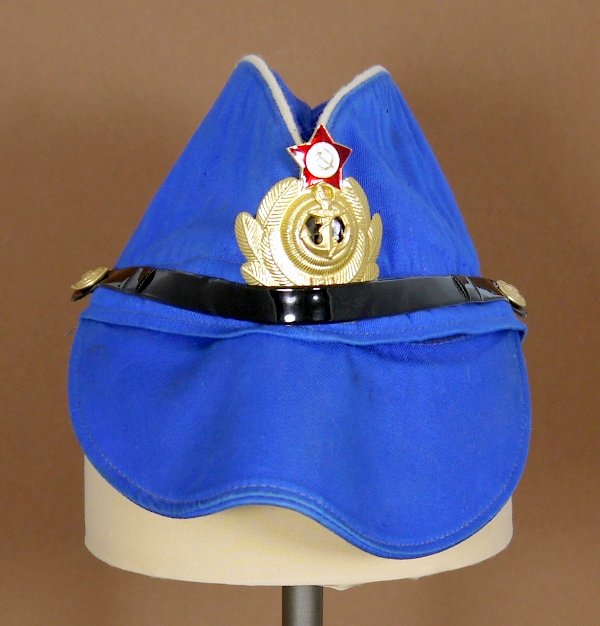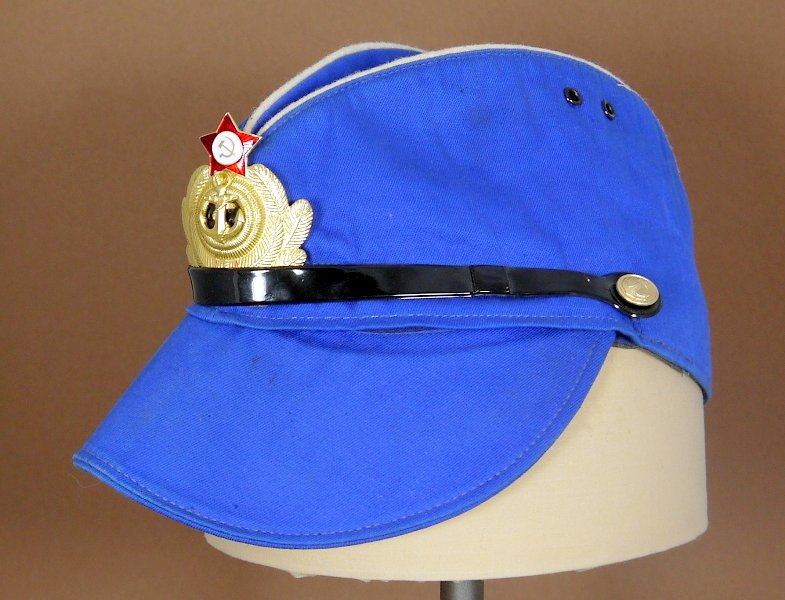 Visor Caps of the Soviet Navy
Visor Caps of the Soviet NavyIntroduction
Included in this section are caps worn by officers and sailors of the Soviet Navy during the Cold War. Of all the services, Naval uniforms changed the least over this period - with caps worn in 1945 very similar to those produced at the very end of the USSR except for changes in fabric and use of aluminum stampings. This resistance to change even extended into the late 1990s when officers were still wearing insignia of the Soviet Navy almost a decade after its fall. In contrast to the Army and Air Force - Naval uniforms and caps were relatively color-challenged. To paraphrase the famous automobile maker Ford when asked why the Model T car didn't come in bright colors: "You can have a Model T in any color you want - as long as you want black!" In the Soviet Navy - caps came in either black or white; there was no colored piping or band. However, the Navy was the first to introduce visor ornamentation for officers and orange and black colored "Guards" bands did add a nice splash of color to those sailors lucky enough to be assigned to a ship or command so designated.
Although the color palette of the Soviet Navy was limited, it did have the widest range of uniform types of any service. In addition to categorizing uniforms into summer and winter versions of Parade/Parade-Walking Out, Service (for everyday), Work (sailors only) and Field (Naval Infantry only); the Navy subdivided the first two into numbered variations. Fortunately for cap collectors - typically the same cap served with multiple uniforms. For uniform aficionados, I shall try to define these as I track down through the cap descriptions. Finally, I am sad to say that Soviet Naval Infantry - while it did get a unique (and very sharp) uniform in 1963 - wore berets, not visor caps, and so are not represented here. Due to the large number of caps to be described, I have broken down this section into two pages - this one in which I describe officer and petty officer visor caps - and one titled "Beskokirka" in which I discuss the visorless caps worn by Soviet sailors and cadets. A thumbnail image accompanies each cap description. Clicking on that thumbnail will bring up a larger, higher resolution image.
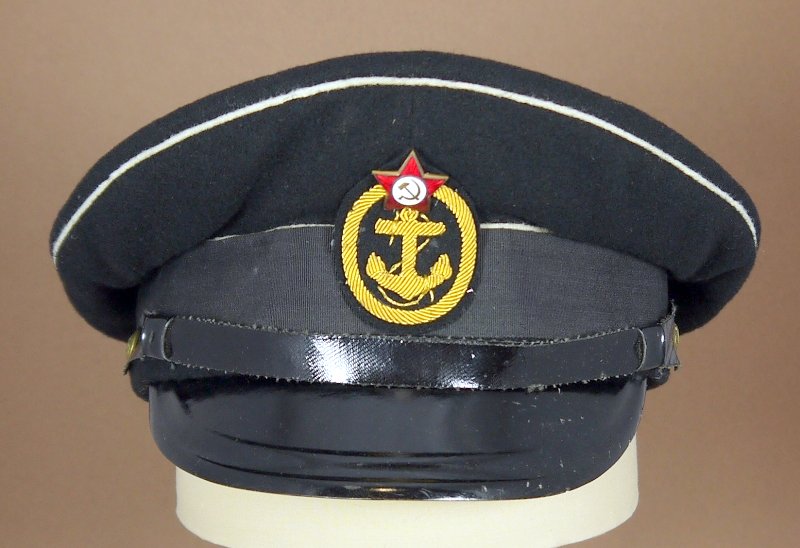
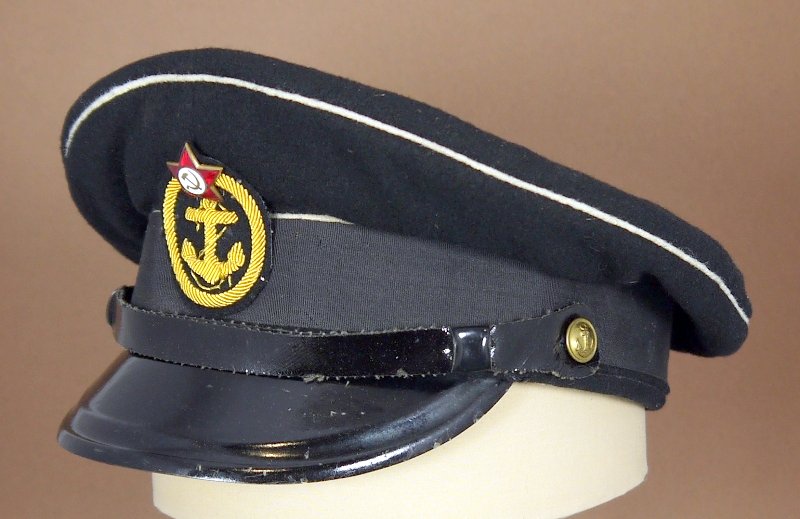 Chief Petty Officer
Chief Petty Officer
Winter Service/Parade
1940-1968
Although dated 1954, the style of this cap did not change for almost a 30-year period. Naval caps were unique in this regard - unlike Army and Air Force caps that experienced numerous changes in emblems and color over this same period. As you will see later, Navy seamen typically wore a visorless cap called (in Russian) "beskozirka." However, if that seaman re-enlisted in the Navy after his conscript service was completed and achieved the rank of Michman, Chief Petty Officer (Glavny Starshina) or Petty Officer (Starshina) 1st or 2nd class - he was authorized to wear a visor cap. In the case of the Michman - an officer's cap, and in the case of a CPO - the cap and special emblem shown here. First authorized in 1940, this unique oval badge had gilt wire embroidery around its edge and a fouled anchor in the center. A enameled red star (with the white center) was pinned at the top of the badge. This special cap emblem was eliminated in the 1969 regulations.
The rest of the cap was the same as for a junior naval officer: black and white wool, brass anchor-embossed buttons holding an
oilcloth strap above a black semi-circular fiberboard visor. As with other naval visor caps of this period, this cap would have stood double duty as part of both winter service and parade uniforms.
Scarce
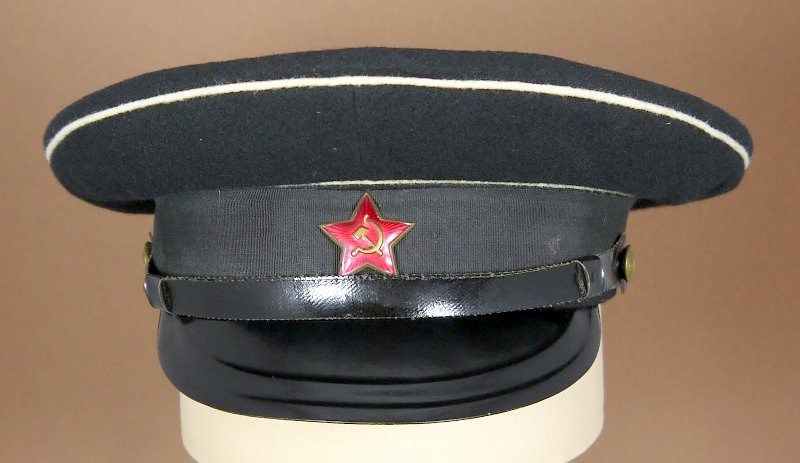
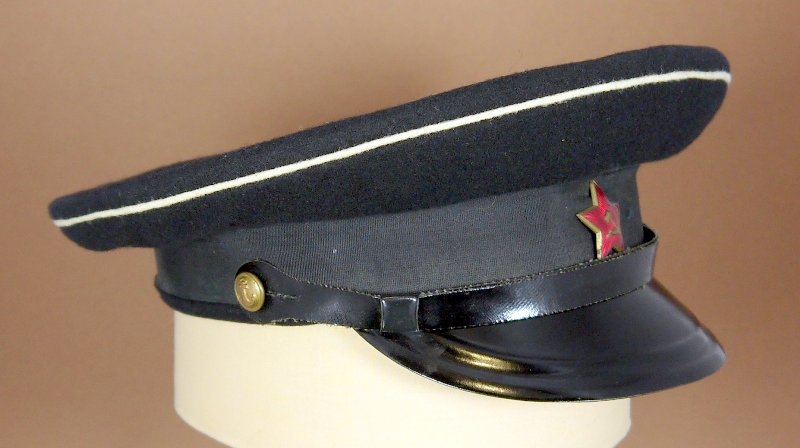 Petty Officer 1st/2nd Class
Petty Officer 1st/2nd Class
Winter Service/Parade
1954-1968
This seldom seen combination of a naval visor cap adorned with the simple red star more commonly seen on the visorless "beskozirka" was in fact authorized for wear by Petty Officers (Starshina) 1st & 2nd class and the equivalent Navy Sergeants and Junior Sergeants who had re-enlisted following their conscript service. It would have been worn on both service and parade. It is the lower-rank counterpart of the cap for Chief Petty Officer's cap described above. The structure of the cap is typical for pre-1969 - with a small, napped-wool crown, a rounded fiberboard visor (the squared-off visor was never very popular in the Navy), brass Navy buttons and black oilcloth chinstrap.
The key distinguishing feature for this cap is the use of the brass coated steel and enamel star in place of the cockades used by higher ranking naval personnel. Wear of this star/visor combination was abolished in the 1969 uniform regulations when such re-enlisted personnel (and later warrant officers - Michman) were authorized to wear the officer's cockade.
Scarce
| To complicate Navy uniform matters further, you will need to understand that non-shipboard personnel (including Naval Infantry, aviation, coastal defense, and others) were referred to by Army-style ranks and had special uniform distinctions (usually piping color and shoulderboard insignia) to separate them from their shipboard (or line) brothers. For example, a shipborne senior NCO would be called "Chief Petty Officer ("Glavny Starshina") while the same rank in the Naval Infantry or in Naval Aviation would be called a Senior Sergeant. Same for officers: Captains 1st Rank and Colonels (Polkovnik) were the same rank. And the Soviet Navy probably had as many generals as it had admirals! See the two charts below from the 1958 Ministry of Defense Uniform Regulations showing Army-themed Navy ranks on the left and equivalent shipboard Navy ranks on the right. Fortunately for us, caps were not really impacted by that difference - except for the use of silver ornaments by engineer-technicians and the wear of berets by Naval Infantry personnel instead of caps. |
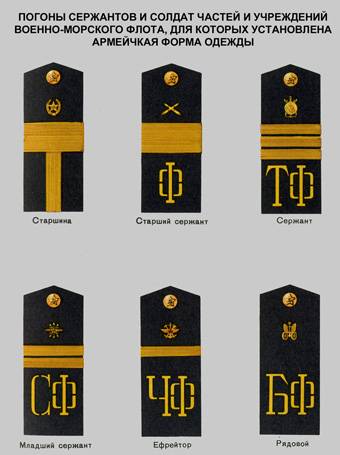
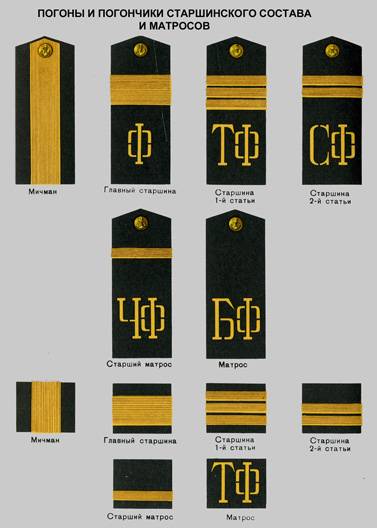
|
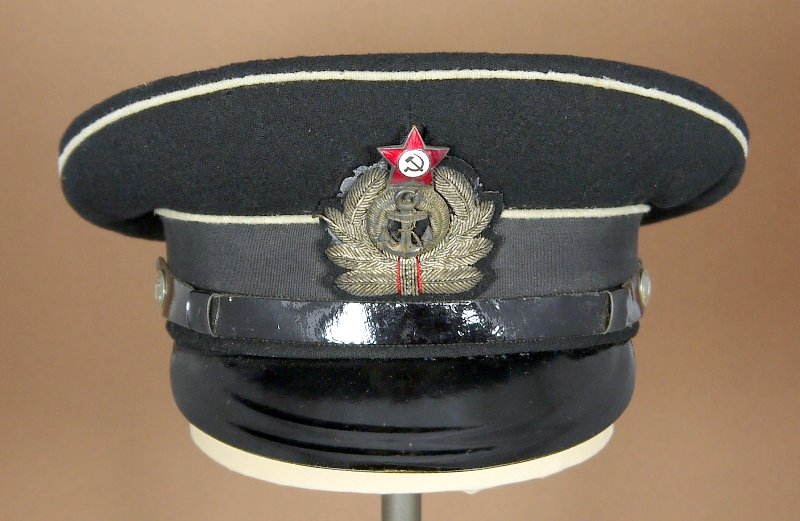
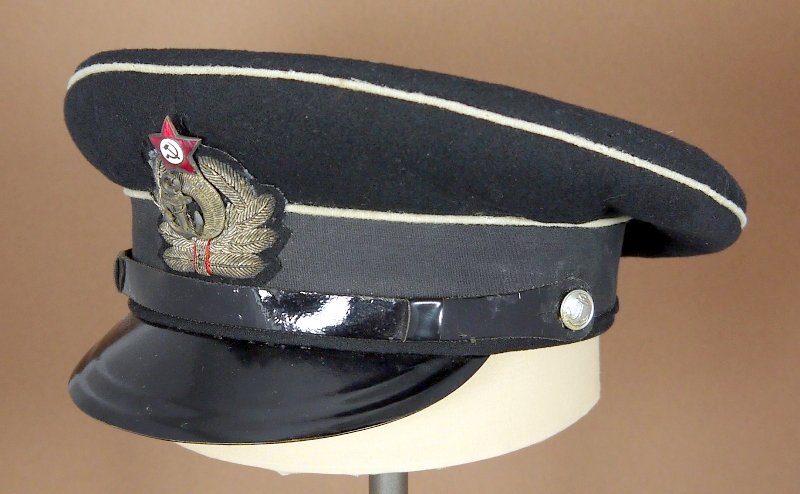 Officer Engineer/Technician
Officer Engineer/Technician
Winter Service
1954-1968
A counterpart to the previous cap but made before 1969. The metallic silver ornaments on this black and white wool cap indicate it was worn by a Naval officer of the Engineer-Technical, Administration, Intendance, Justice, Medical or Veterinary services. The silver cockade (called a "crab" in Russian) is embroidered from silver wire - heavily tarnished in this case. These early cockades were very finely crafted from multiple pieces - with separate
anchor, twisted wire around that anchor, central two-rimmed cockade with red and white enamel star and a wreath embroidered onto a separate wool backing and then sewn or pinned onto the band. Note the naval-unique star - with the white circular center surrounding the hammer and sickle.
Naval caps were also unique in that the band was covered with a black ribbon with a distinct top-to-bottom ribbing. This was sewn closed at the rear of the cap. To ensure the ribbon stayed on the cap, a raised ridge was sewn around the bottom of the band. This sandwiched the ribbon against the crown and was also
unique to naval caps. Two silver (matching the emblem color) buttons with the naval anchor stamped on the metal face held a black oilcloth chinstrap in place. The visor is black lacquered fiberboard of the 1954 pattern (semi-circular with two rims).
Scarce
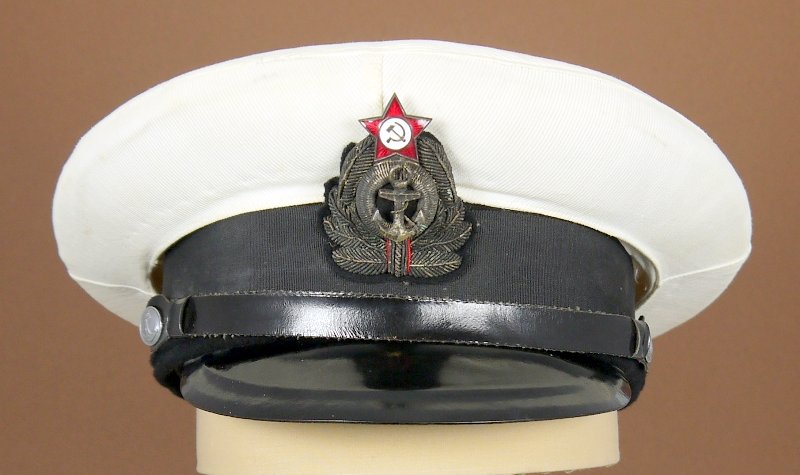
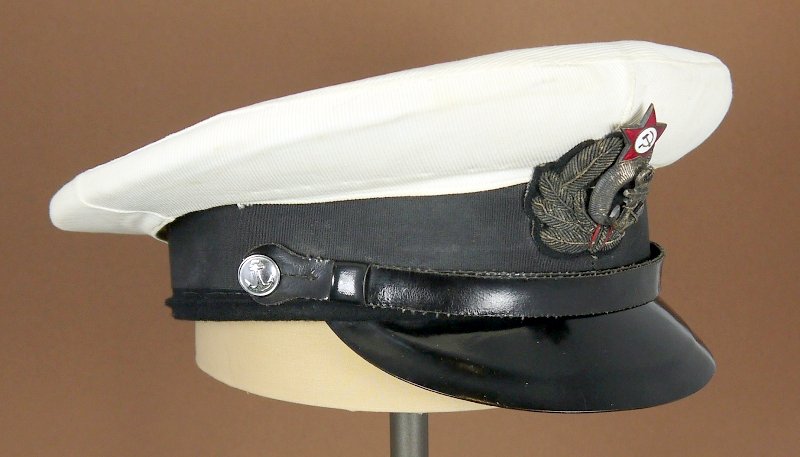 Officer Engineer/Technician
Officer Engineer/Technician
Summer/Tropical Service
1954-1968
Very similar to the previous cap - but with a removable white cotton top for hot weather wear by junior officers. As you can see in greater detail further down this page, this cap is actually a lightweight shell consisting of a visor, band and padding - over which the cover is stretched.
Once again - you can see the heavily tarnished silver early 4-piece cockade. This emblem is only sewn along its lower edge (pinning was actually more common) - to enable the white cover to be removed without having to detach the emblem.
The black oilcloth strap and fiberboard visor are standard for this period.
Scarce
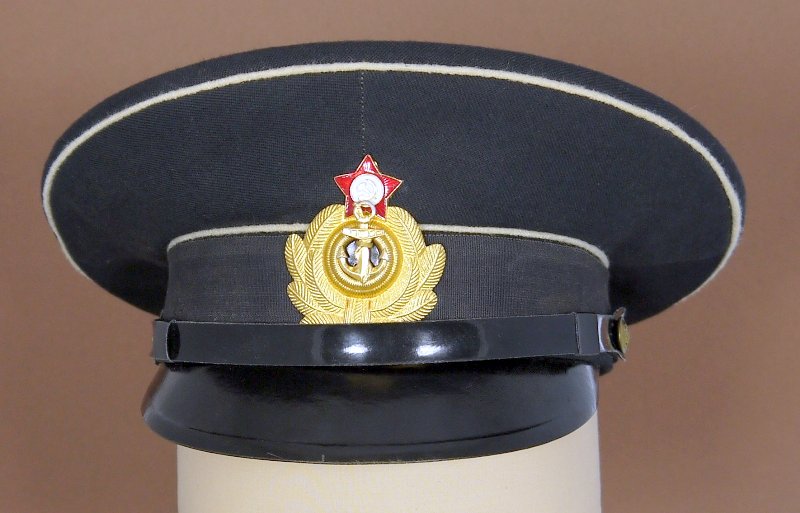
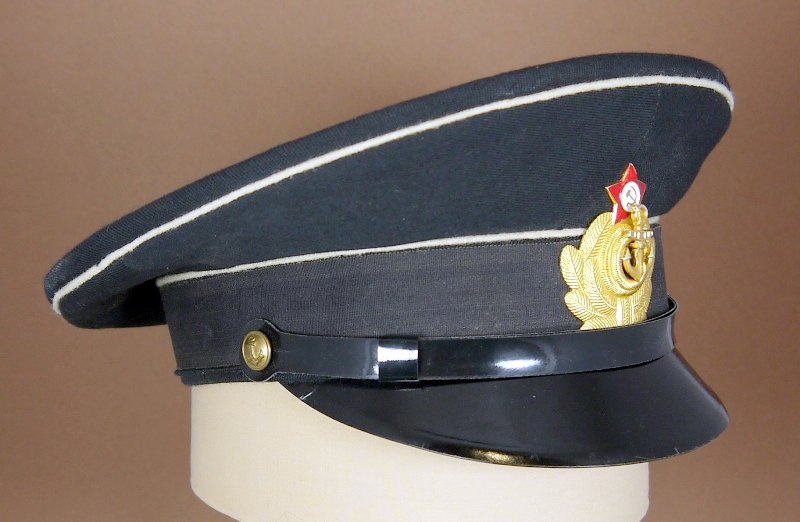 Line Officer
Line Officer
Winter Service
1969-1974
The basic Soviet naval junior officer cap. As with the other Navy caps on this page, presence or absence of gold cords and visor leaves identified both the rank of the wearer and the class of uniform. Junior officers up to 1975 always wore black straps on their caps - both for service and for parade. While those same officers (Junior Lieutenant; Lieutenant; Senior Lieutenant and Captain-Lieutenant) would have worn metal leaves on their cap visors for parade wear; the service cap shown here would not have that ornamentation. This cap has the larger M69 crown made of blended wool fabric, a two-piece stamped anodized aluminum cockade and the standard black ribbed silk ribbon around the band. The gilt ornaments (cockade and buttons) indicate the wearer was a shipboard or line officer. The visor is fiberboard.
Although I list this cap as belonging to a junior officer, a Michman (after 1972) and extended service Petty-officers or Navy sergeants would also have worn this cap for both everyday service and parade.
A white-topped summer version of this cap also existed.
Common
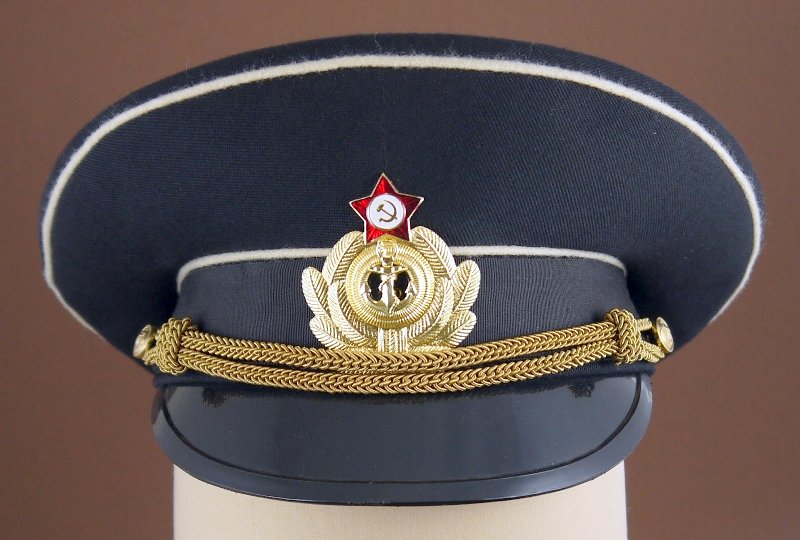
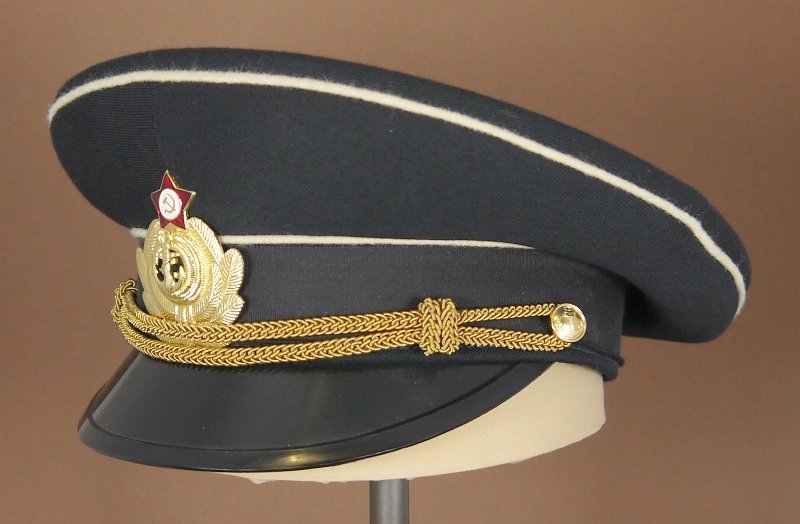 Officer
Officer
Winter Service
1975-1991
In 1975, the Ministry of Defense authorized all officers (except warrant officers/michman) to wear gold filigree cords on their service caps - replacing the previous black oilcloth strap. This cap - dated 1987 - is a typical late-period version. The crown is made of blended wool fabric, the visor is black plastic, the buttons are gilt plastic, and the emblem is the two-piece stamped aluminum with painted enamel star. All junior officers would have worn this cap with their everyday uniform. Also as of 1975, all silver ornaments were abolished - technical, administrative and medical officers now wore the same gilt fittings as line officers.
Your attention is also drawn to the ribbed silk band. Notice in the side picture how it completely covers the width of the band - except for the bottom edge. Compare this to the next cap - which was made in 1989.
Common
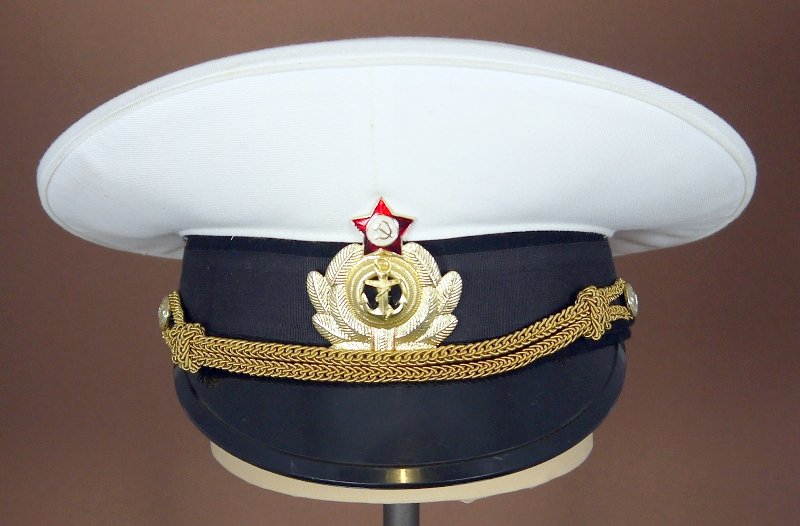
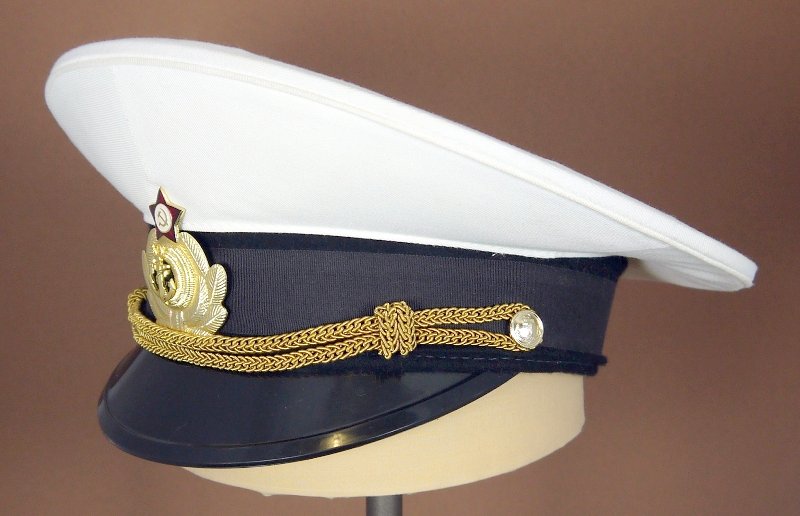 Officer
Officer
Summer Service
1975-1991
A summer version of the above cap - all junior officers wore this style for everyday service after 1975. Junior officer parade caps would be the same, but with the addition of stamped metal visor leaves. As with previously described summer caps, the cover of this cap is removable. The emblem is the late-period stamped 2-piece, buttons are plastic, and the visor is plastic - all characteristic of a late-model cap.
However, a close look at the band ribbon shows that it does not completely cover the band - with a 1/4 inch gap at the top where the black band shows.
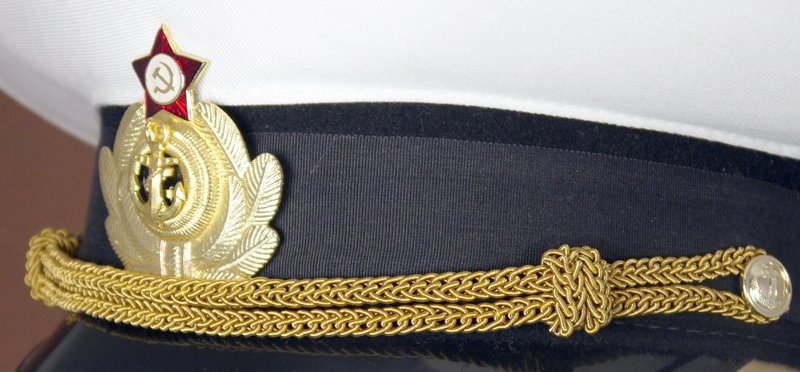
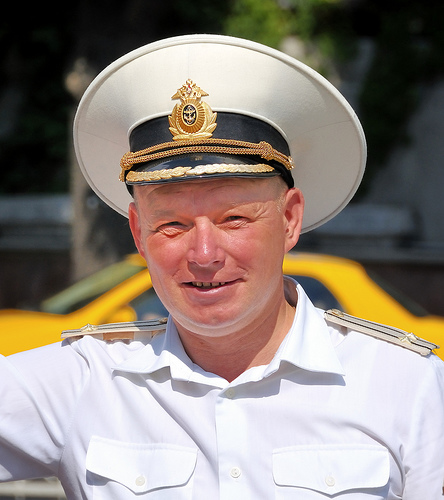 This is characteristic of caps manufactured after 1988. Although not formalized
in regulations, crown size and band height increased again over that of the M1969 caps: crown height by 1/4 inch and circumference by 1/4 to 1/2 inch. This larger-style cap (M1989?) apparently originated within the Navy, but eventually expanded to all services.
The popularity of the increased crown was such that, after 1991, the Russian military adopted even LARGER size crowns - such as shown here from www.flickriver.com. The resulting caps became the butt of jokes within the world's militaries and resembled nothing so much as a parody of South American militaries.
Fortunately, the Russian military has finally come to its senses and has returned to a cap size similar to the M1969.
Common
This is characteristic of caps manufactured after 1988. Although not formalized
in regulations, crown size and band height increased again over that of the M1969 caps: crown height by 1/4 inch and circumference by 1/4 to 1/2 inch. This larger-style cap (M1989?) apparently originated within the Navy, but eventually expanded to all services.
The popularity of the increased crown was such that, after 1991, the Russian military adopted even LARGER size crowns - such as shown here from www.flickriver.com. The resulting caps became the butt of jokes within the world's militaries and resembled nothing so much as a parody of South American militaries.
Fortunately, the Russian military has finally come to its senses and has returned to a cap size similar to the M1969.
Common
|
As you will see as you view the caps on this page, there were a number of variants of the Navy officer
emblem. Not only did they come in both gold and silver - but in 2, 3 and 4 piece, and in wire embroidery and stamped aluminum. Shown on the left are five versions.
The top three in gilt are for line (operational) officers while the bottom silver ones are for engineering-technical and other non-line officers.
The top left and bottom left emblems are 4-piece with hot enamel stars. All Navy officers wore these in the 1940s, 50s and early 60s - since stamped emblems were not manufactured until 1968-69.
The top middle shows an embroidered wreath with a stamped aluminum cockade and lacquer star. This 3-piece version (rope and anchor were one cast piece) was commonly worn by senior officers after 1969.
The last two emblems - top and bottom right - are stamped in two pieces with lacquered stars. These all-aluminum emblems were commonly associated with new, junior officers; probably due to their low cost.
The second picture shows the backs of these pieces. The stamped 2-piece emblems are on the top and bottom right (see how the anchor/rope is a separate piece pinned through the cockade). The other three are embroidered versions - top middle is the post-1969 3-piece version; top and bottom left are pre-1969 4-piece versions. |
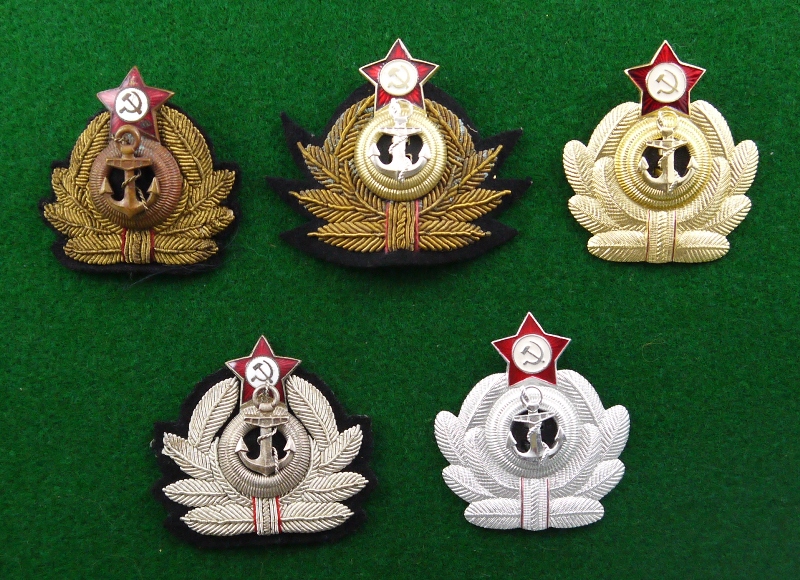
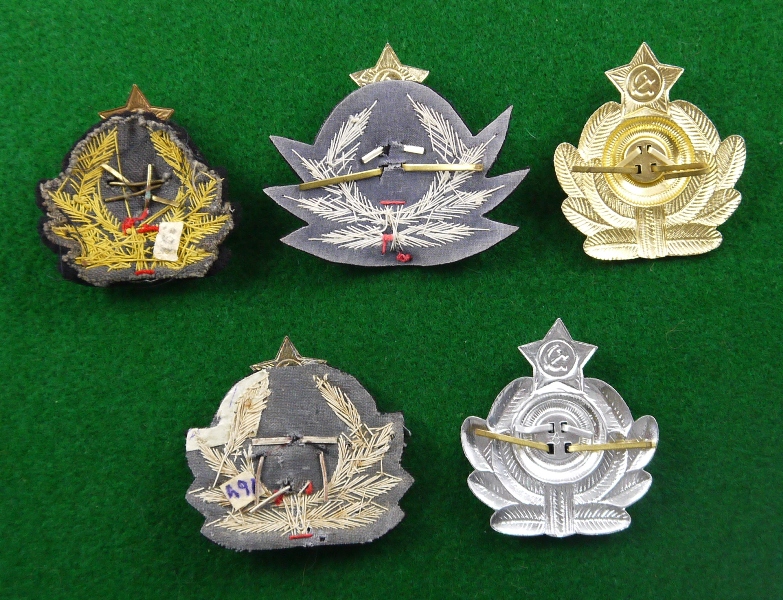
|
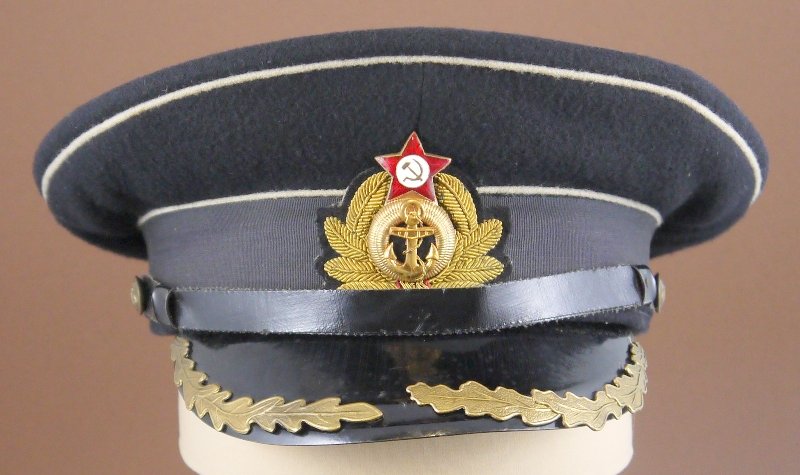
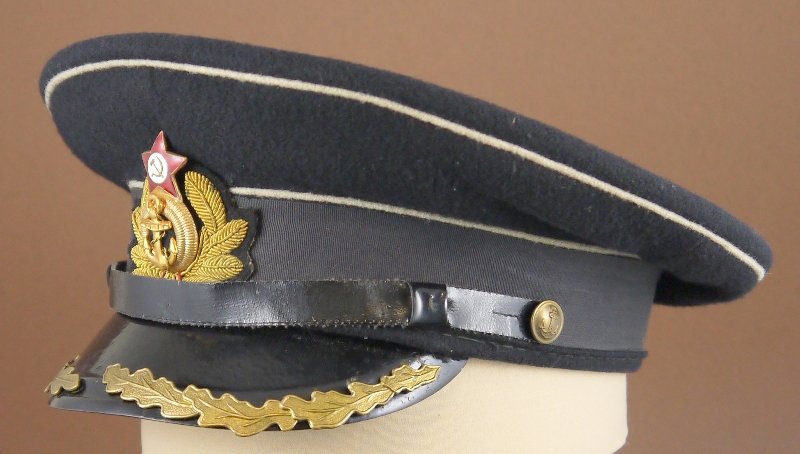 Line Officer - Captain 2nd/3rd Rank
Line Officer - Captain 2nd/3rd Rank
Winter Service/Parade
1945-1954
Second and Third-rank Captains and equivalent Naval Majors and Lieutenant Colonels wore this cap for both service and parade purposes. More junior officers were authorized to wear this same style only on their parade caps.
All ornaments are in gilt, indicating line (shipboard) officers or operational shore officers.
The cockade is the four-piece version: a cockade with attached red star, anchor, wire twisted around that anchor - all pinned to the wreath that is then sewn to the band. Napped wool crown, oilcloth strap and brass buttons are standard.
What identifies this specifically as belonging to the two field-grade officer ranks are the two metallic strips pinned through the visor simulating leaves. If you look closely, you can see the two halves of the leaves do not match - in fact the one to the right in the photo was originally meant for a spade-shaped visor.
Spade shaped visors were reportedly not very popular with Naval officers (unlike Army officers) and served side-by-side with semi-circular ones such as shown here until completely phased out in 1954. The owner of this cap apparently used what was available - resulting in a mix of two pre-1955 leaf styles - designed for both spade and semi-circular visors. These early leaves were made with just two attachment pins; the 1955 model featured a more detailed design with three pins.
Scarce
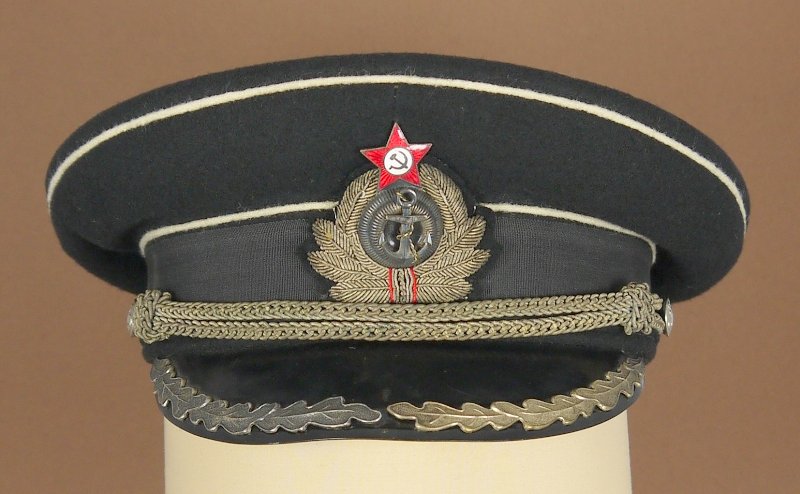
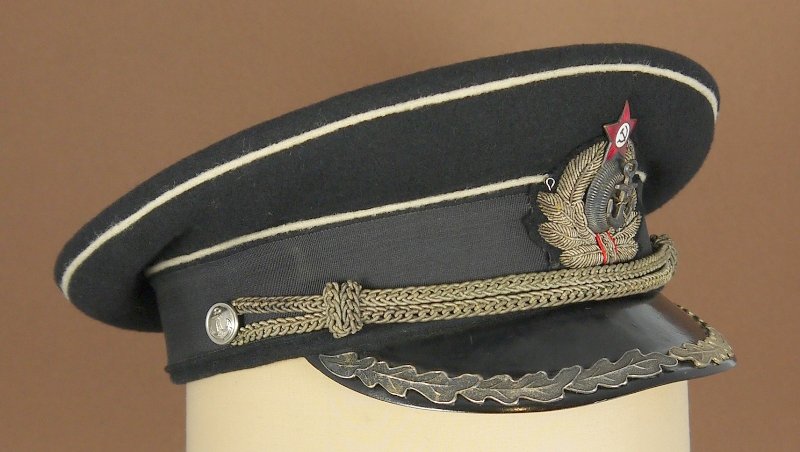
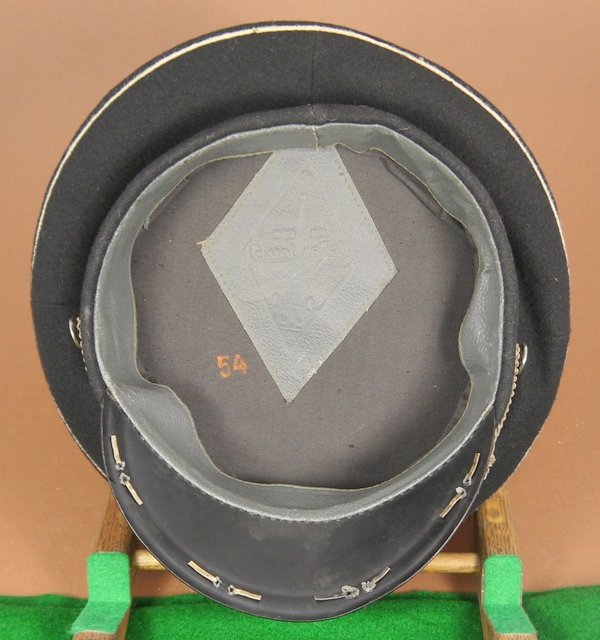 Officer Engineer/Technician - Captain 1st Rank
Officer Engineer/Technician - Captain 1st Rank
Winter Service/Parade
1945-1954
This is a rather rare cap belonging to a Captain 1st Rank (or Navy colonel) of Engineer-Technical, Administration, Intendance, Justice, Medical or Veterinary services: as evidenced by the overall use of silver ornaments.
The emblem is an early 4-piece version in silver wire and plating. This is rather heavily tarnished, as was common on these older emblems due to their real silver content. The red and white star are hot glass enameled.
Buttons are silver colored, two-piece versions with steel backings. What really makes this cap unusual, however, is the silver filigree cords and the silver visor leaves.
Gold and silver cords were only authorized to Captains 1st Rank (and Navy colonels) in 1945 while visor leaves dated back to 1943. Not until 1975 did other, more junior officers earn the right to wear these cords - and by then, silver ones were abolished.
That helps to make silver naval cords quite rare. The visor leaves are stamped metal (not aluminum) of a very early design - probably dating from 1943. This design is what identifies the cap as pre-1955, when a new style of visor leaves was introduced.
These leaves are pinned through the semi-circular fiberboard visor by clasps; two for each side.
As to the rest of the cap: the crown is the small size used before 1969, made of napped black wool with white wool piping. A black ribbed silk ribbon encircles the band and the emblem is attached by pins.
Rare
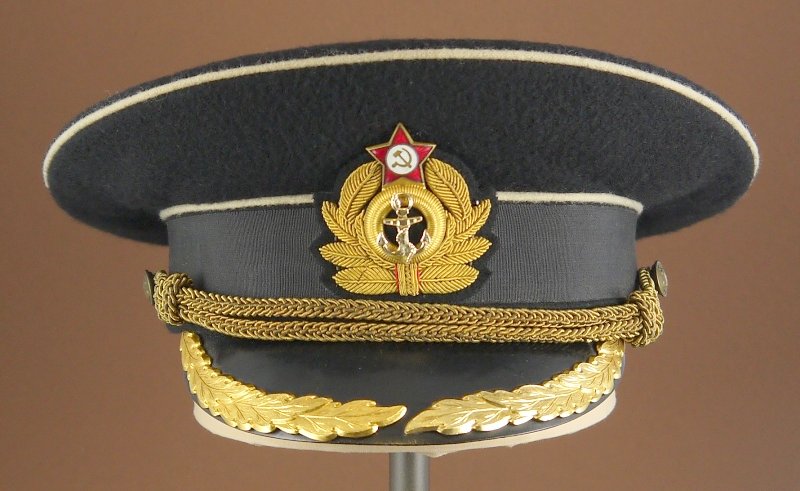
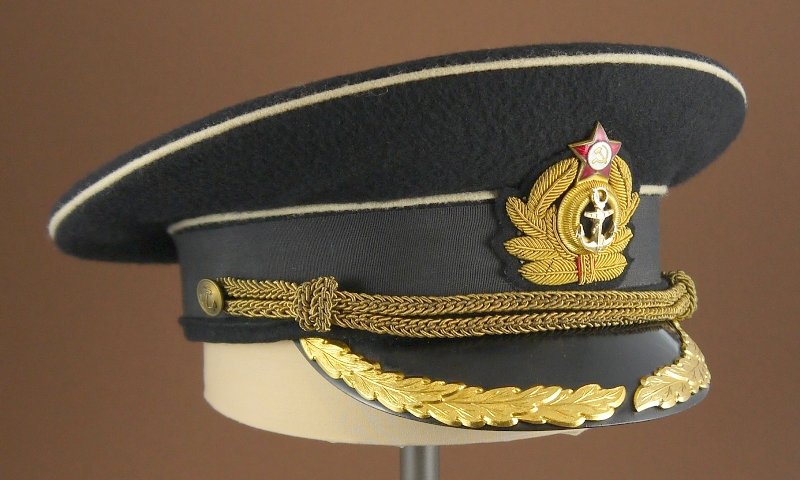 Line Officer - Captain 1st Rank
Line Officer - Captain 1st Rank
Winter Service/Parade
1955-1968
The presence of gold filigree cords in conjunction with gilt visor leaves uniquely identify the owner of this cap as a Captain 1st Rank (or Naval Colonel) of shipboard or an operational shore command.
Until 1975, ONLY Admirals and Captains 1st Rank wore cords instead of the black oilcloth strap.
Made in the 1950s, this cap illustrates normal features of that period: black napped wool crown, gilded steel buttons, and a three-piece Navy officer's cockade (wire embroidered leaves, brass or tombac center rim with hot enameled star, with a one-piece aluminum anchor). This anchor "probably" was a replacement for a lost two-piece anchor and wire piece.
The visor is fiberboard with M1955 style anodized aluminum leaves pinned through it. The pinning style indicates these were added some time after manufacture.
This same cap was worn for both service and parade wear.
Scarce
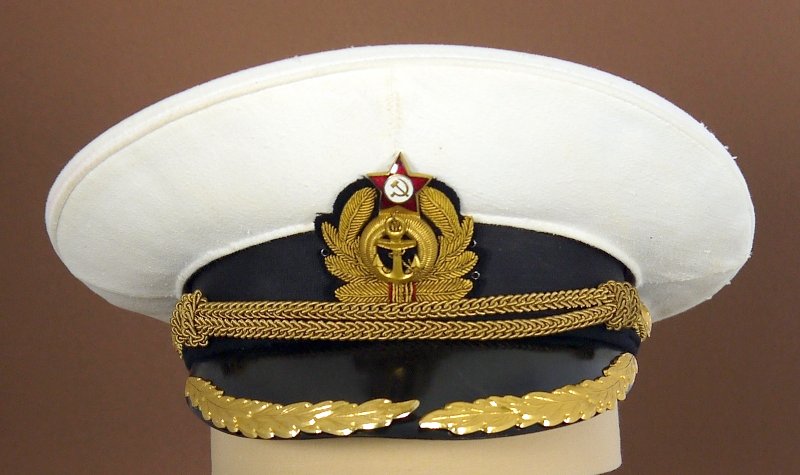
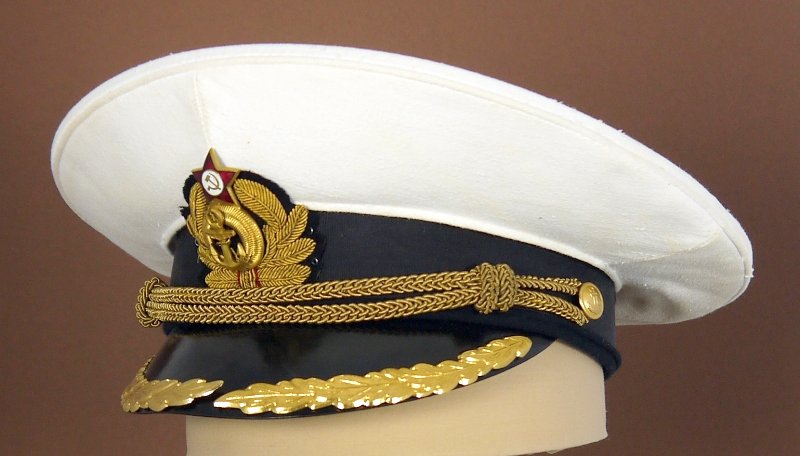 Line Officer - Captain 1st Rank
Line Officer - Captain 1st Rank
Summer Service/Parade
1969-1991
This undated cap is a summer version of the cap just described and combines elements of both post and pre-1969 manufacture. It has the higher and larger crown of the M1969 style, and like the one above, has M55 style aluminum leaves
pinned through its fiberboard visor, gold cords and gilded steel buttons. However, the cockade is a very high quality pre-69 four-piece version - with wire embroidery, brass or tombac rim with hot enameled star and separate anchor and wire rope pieces.
This probably reflects the owner transferring his cockade from an earlier style cap to this later one. These embroidered naval cockades were typically held in place with pins (vice sewing), which made their removal very simple.
As for most post WW2 summer caps, the cap itself is a "skeleton" structure - consisting of a band, visor and crown padding. The white cover was stretched over this padding and given shape by a spring-steel band.
Available
| The three pictures below show a summer officer's cap with its white cover removed. A look at my Beskozirka page shows that both these caps had an identical internal structure - with the exception of the visor. These pictures show the internal padding and light linen fabric over which the cover was positioned. Interestingly enough, on every such summer cap I've examined, the cover had TWO spring-steel bands - vice the single band on other caps. One held the cover at tension - preventing wrinkles, while the other held the cover tight against the padding. Also notice the Navy emblem is pinned to the band such that the cover can be removed without disturbing the emblem. As with the white beskozirka covers, two extra covers were typically provided with the basic cap. |
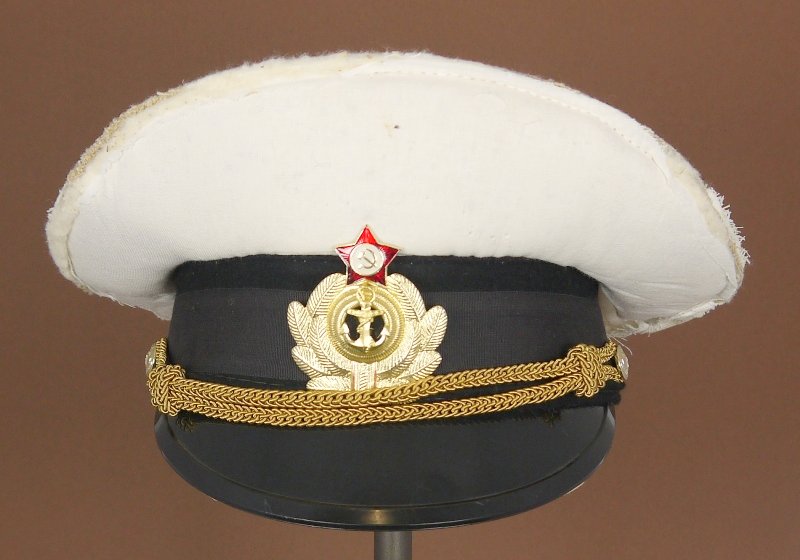
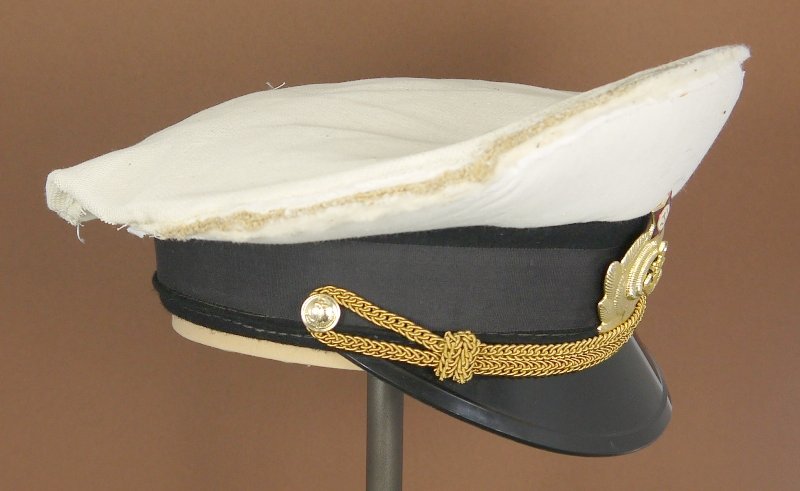

|
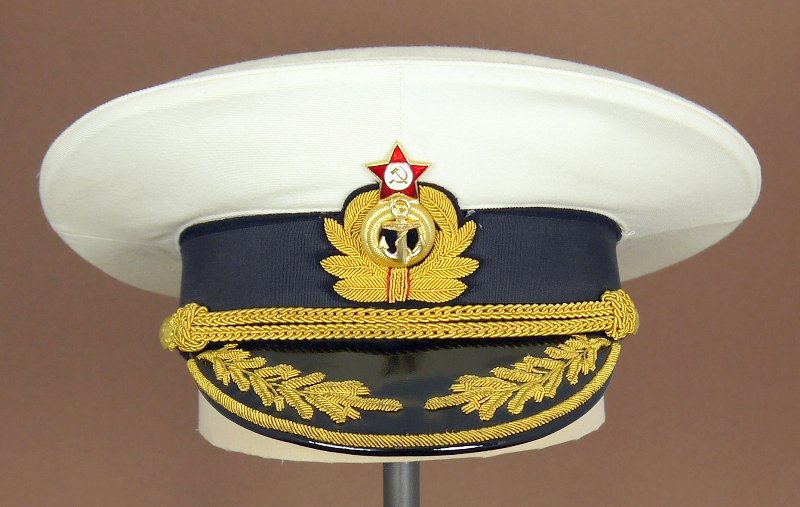
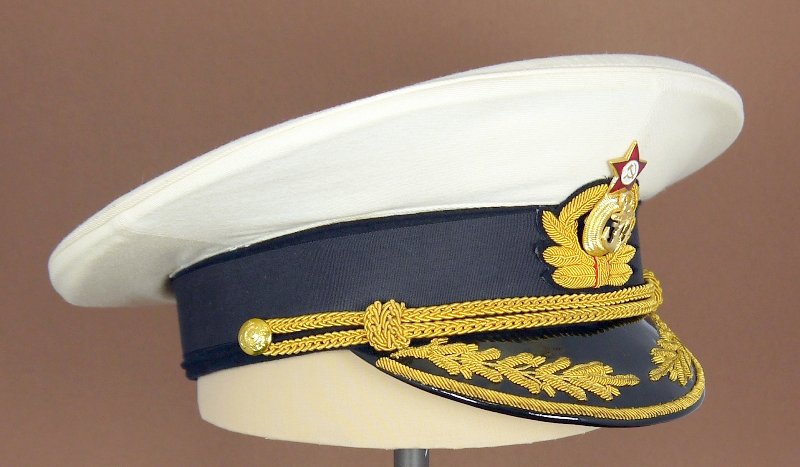 Admiral/Navy General
Admiral/Navy General
Summer Service
1969-1991
All Admirals and Navy Generals would have worn this cap for everyday duty during the summer. As for other similar Navy caps, the white cover is removable - although in this case is made of wool vice the more typical cotton of junior officer and sailor caps.
The embroidered wreath and aluminum cockade on this cap is the same as that which could be found on more junior officers,' as are the gold filigree cords.
What identifies this as belonging to an Admiral is the visor embroidery. This pattern of stylized leaves was unique to the Navy; differing from the laurel and oak leaves used in the Army and Air Force.
Both the leaf and the rim along the outside edge of the visor is high quality wire embroidery sewn onto a patent (chrome) leather top. The visor is then lined in black wool on the underneath, just as in Army/Air Force general visors.
The interior of this cap is also rather unique to the Navy, with the real leather sweatband and maker's label found in all general-officer caps; but with a white cotton lining only found
on white summer caps. Notice too, this cap retains the traditional black ribbed ribbon over the band as for all Naval caps, regardless of rank. The buttons holding the cords in place are for Admirals - with the Great Seal of the USSR superimposed over crossed anchors.
A black version of this cap also existed for service wear during the winter.
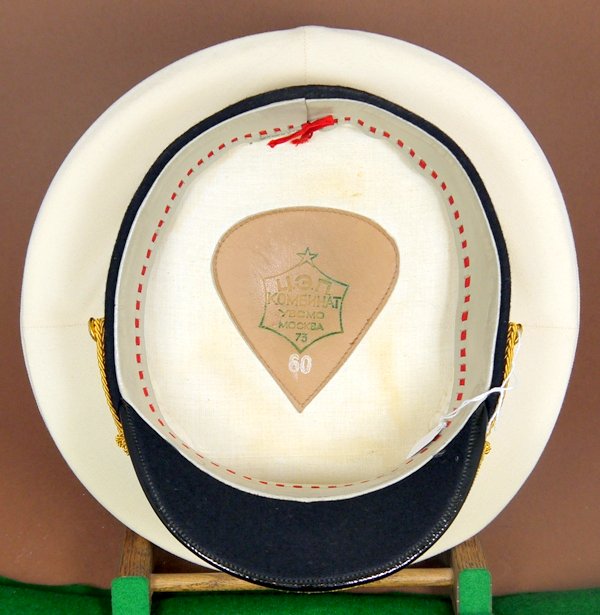
Admirals and Naval Generals of Artillery (until eliminated), Aviation, Technical-Engineering, and Intendance wore gilt ornamentation on their caps over the entire Cold War period.
However, Naval Generals of Medical, Veterinary and Justice services used silver ornamentation on their caps (including the emblem, buttons, cords and embroidery) until 1969.
That year all Navy Admirals and Generals standardized on gilt ornaments.
Scarce
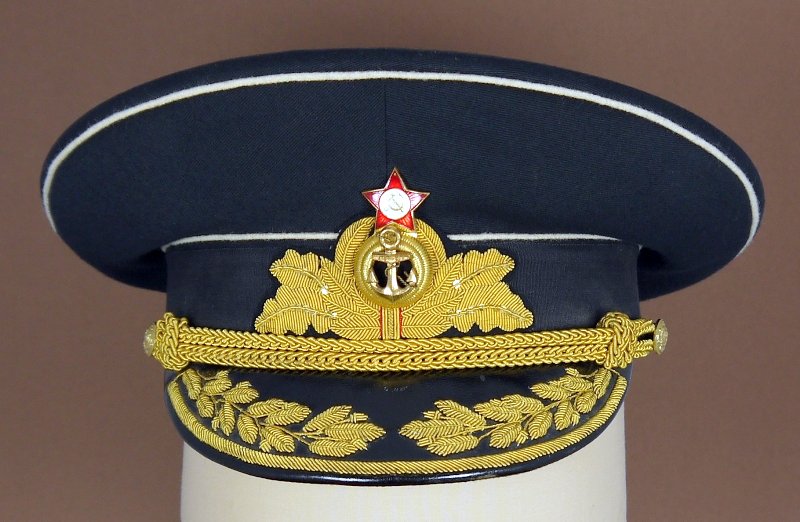
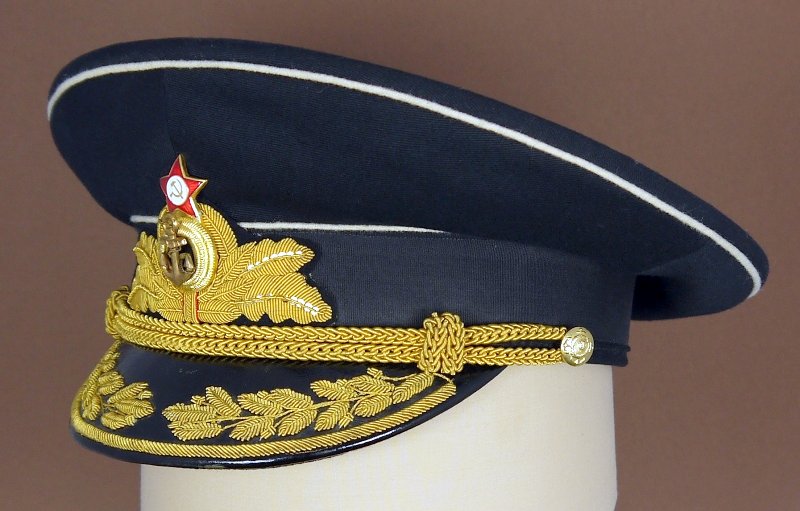 Admiral/Navy General
Admiral/Navy General
Winter Parade
1969-1991
Admirals and Navy Generals wore this cap for parade service in the winter. Most of its elements were the same as for an everyday service version. Although the visor leaf embroidery differs from that on the summer cap above,
this was only a manufacturing variant. This cap also retains the rather simple gold filigree cords of its service counterpart. Contrast this with the embroidered leather strap worn
by Army and Air Force generals on their parade caps. Identification as a parade cap resides with the use of an expanded spray of leaves surrounding the cockade on the band. These leaves are embroidered onto a black wool backing which
is in turn pinned or sewn (as here) to the band. A summer version also existed, with the same removable white cover as found on the summer service cap. Otherwise it was identical to the Winter parade cap described here.
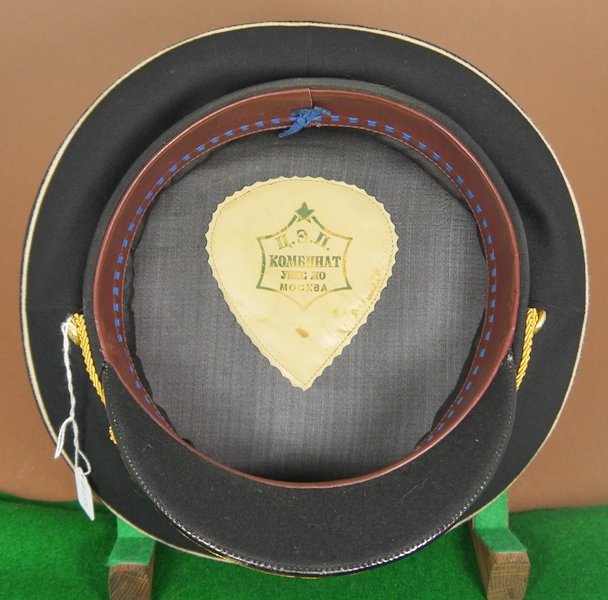
The interior of this cap mirrors that of Army/Air Force generals' caps - with leather sweatband and maker's label along with silk lining with ribbon. However, the lining on Admirals' caps
often used black silk - a color not normally seen for the other services.
Scarce
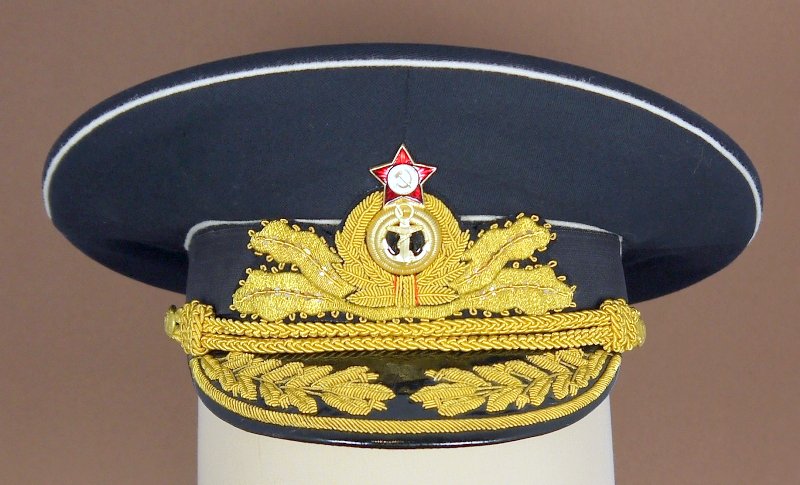
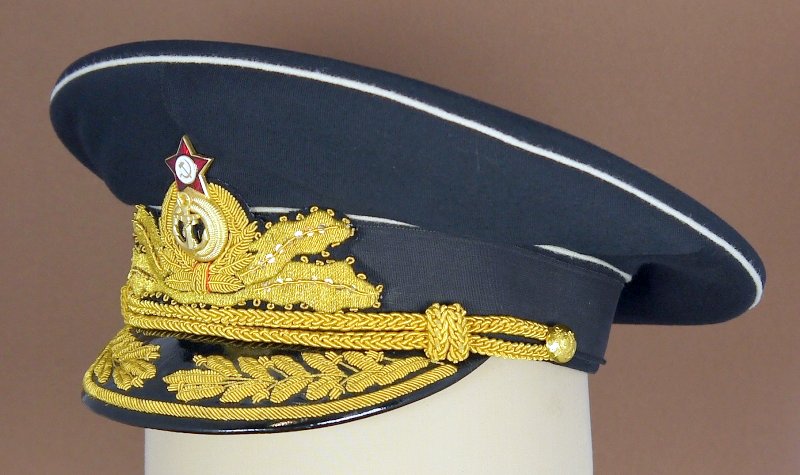 Admiral of the Fleet of the USSR
Admiral of the Fleet of the USSR
Winter Parade
1969-1991
Even rarer than Marshal of the Soviet Union - the rank Admiral of the Fleet of the Soviet Union was conferred on only three men over the period 1955-1991: Nikolai Kuznetsov, Ivan Isakov, and Sergei Gorshkov. This rank was officially equivalent to Marshal of the Soviet Union and should not be confused with the rank Admiral of the Fleet - which was a four-star rank created in 1962 equivalent to General of the Army. Only Admiral of the Fleet of the USSR wore the cap shown here. All others wore the caps described above.
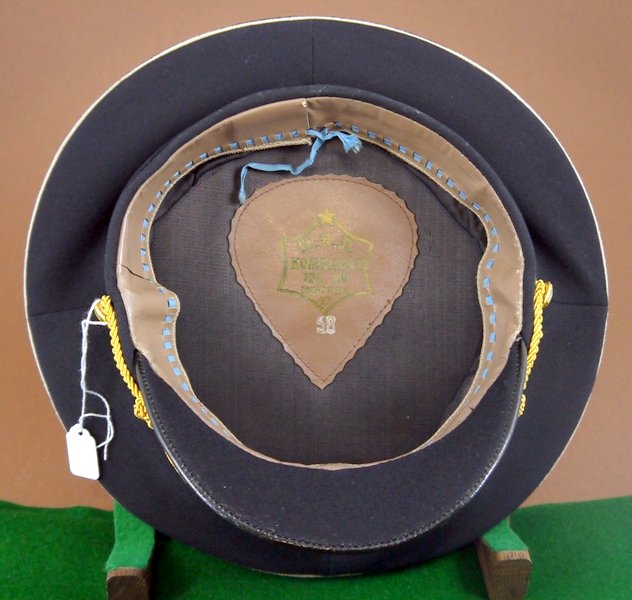 Although dated 1968 on the maker's label, this cap is a M69 model with the larger crown and blended wool crown. In structure and most ornamentation - it mirrors the Admiral parade cap just described.
It has the same stylized leaf embroidery and visor rim, gilt Admiral buttons and gold filigree cords. The interior is also typical Admiral-grade silk and leather.
The defining element of Admiral of the Fleet of the Soviet Union is the emblem pinned to the ribbon band. Notice the much wider spray of leaves - or "wings" extending to the sides.
These large leaves are actually sewn in metallicized fabric thread vice the metal wire embroidery used on the remainder of the cap (and on "regular" admirals' caps). This is not a cheaper reproduction - but what was actually authorized to make them stand out from the rest.
Although dated 1968 on the maker's label, this cap is a M69 model with the larger crown and blended wool crown. In structure and most ornamentation - it mirrors the Admiral parade cap just described.
It has the same stylized leaf embroidery and visor rim, gilt Admiral buttons and gold filigree cords. The interior is also typical Admiral-grade silk and leather.
The defining element of Admiral of the Fleet of the Soviet Union is the emblem pinned to the ribbon band. Notice the much wider spray of leaves - or "wings" extending to the sides.
These large leaves are actually sewn in metallicized fabric thread vice the metal wire embroidery used on the remainder of the cap (and on "regular" admirals' caps). This is not a cheaper reproduction - but what was actually authorized to make them stand out from the rest.
I would love to think this cap actually belonged to one of the three Soviet Admirals of the Fleet of the Soviet Union but cannot realistically assume such. Far more likely was that an Admiral of the Fleet of the Soviet Union emblem/cockade was
substituted for a more common Admiral's parade cockade - possibly for a museum uniform display. Nevertheless - it remains a fine example of this extremely rare cap.
Very Rare
| To more clearly demonstrate the difference between the two parade emblems, the pictures below show them side by side - with the Admiral cockade/emblem on the left and the Admiral of the Fleet of the Soviet Union on the right. |
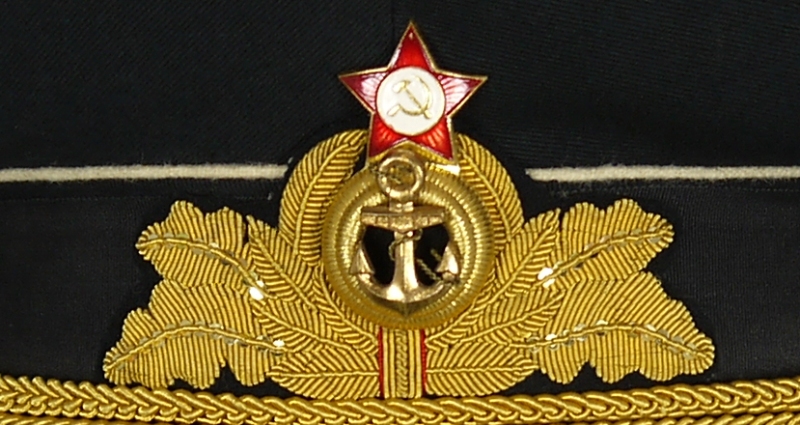
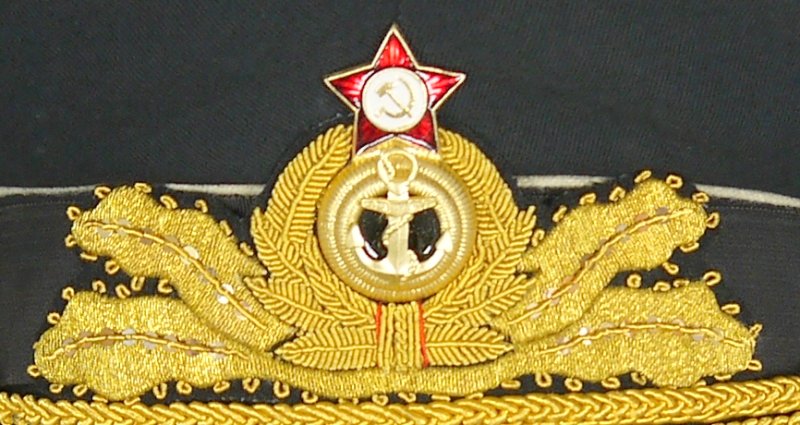
|
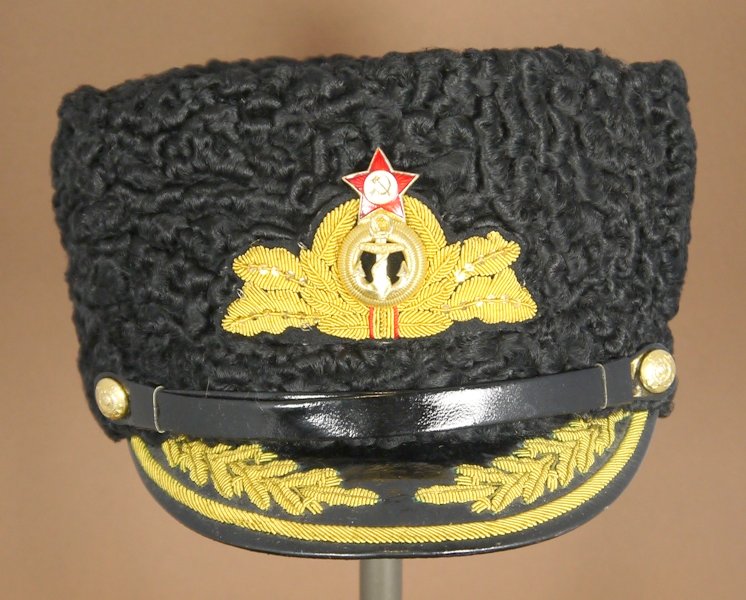
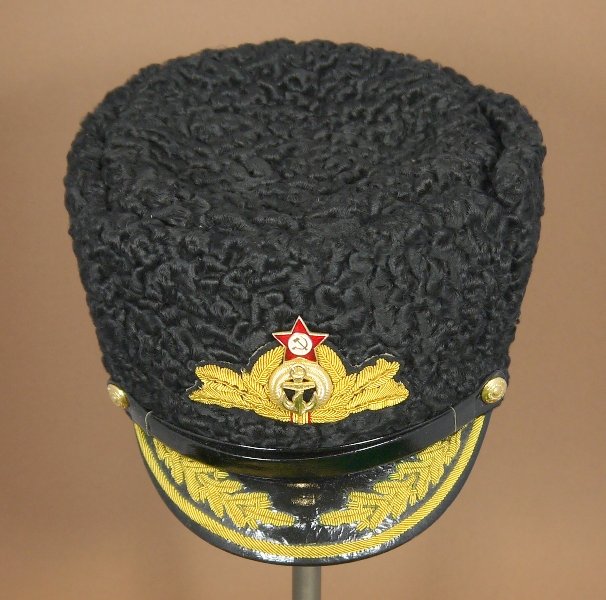 Admiral/Navy General
Admiral/Navy General
Winter Service
1973-1991
Probably the most luxurious hat worn in the Soviet military! Introduced in 1973, this hat design was unique to the Soviet Navy. The hat resembles many other winter Russian fur/wool hats, but with a visor attached. The body of the insulated hat is covered in black lambs-wool, while the visor is made of patent leather embroidered with gold bullion. The black chinstrap is also made of patent leather. An admiral's parade cockade is pinned onto the front flap.
Although a variant of this hat exists for Captains First Rank, this particular hat is an Admiral's (or Navy General's) model, as evidenced by its admiral-grade buttons and cockade and its full lambs-wool top. This cap could be worn when wearing a winter overcoat or padded jacket over a service uniform. It has remained in service with the Russian Navy with minor modifications to this day.
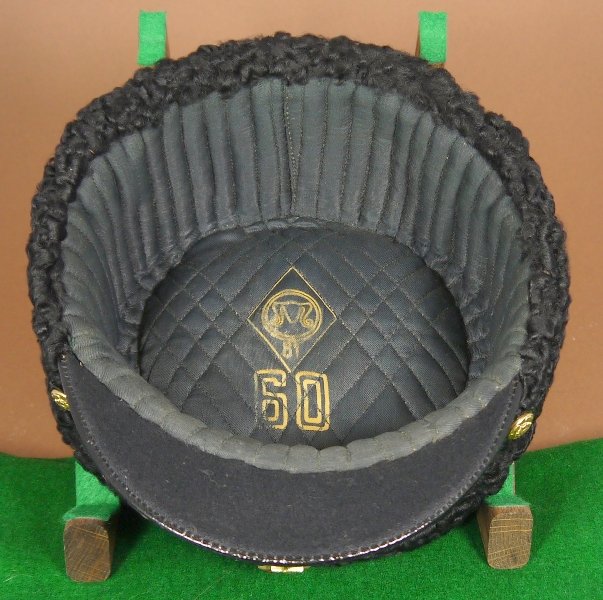
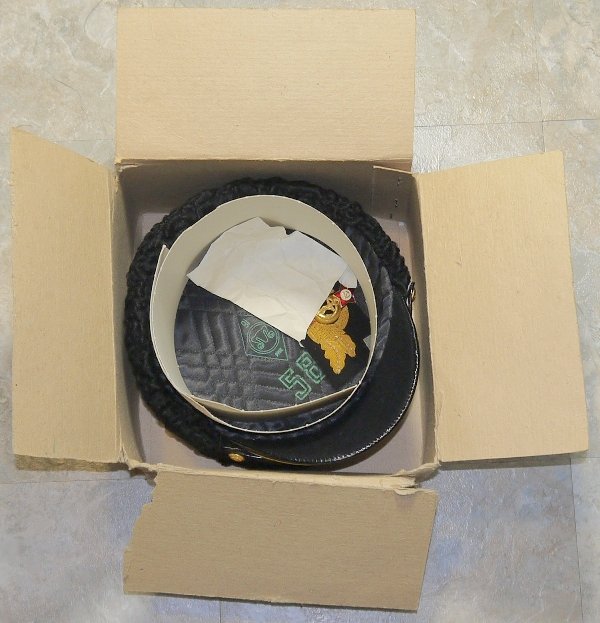
I've added a picture to the right of one of these hats as it was sold in the box at a VOENTORG - also showing the separate packet holding the embroidered wool-backed emblem.
Rare
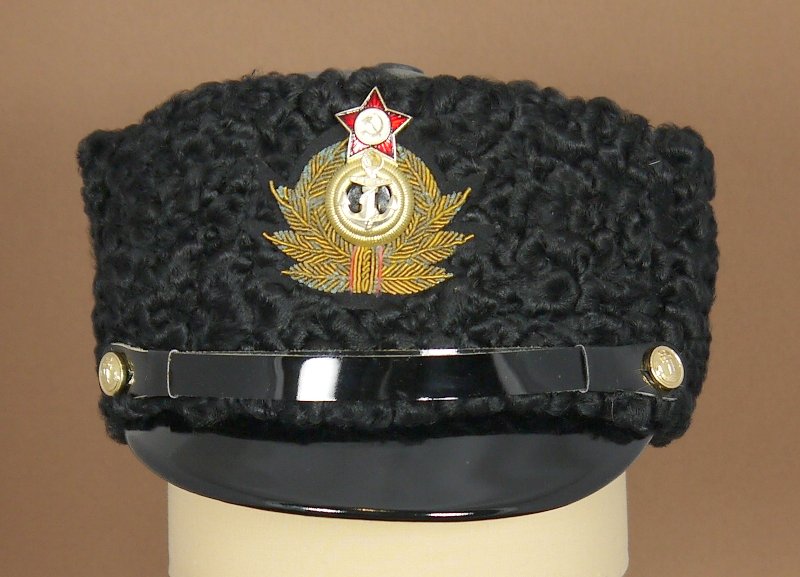
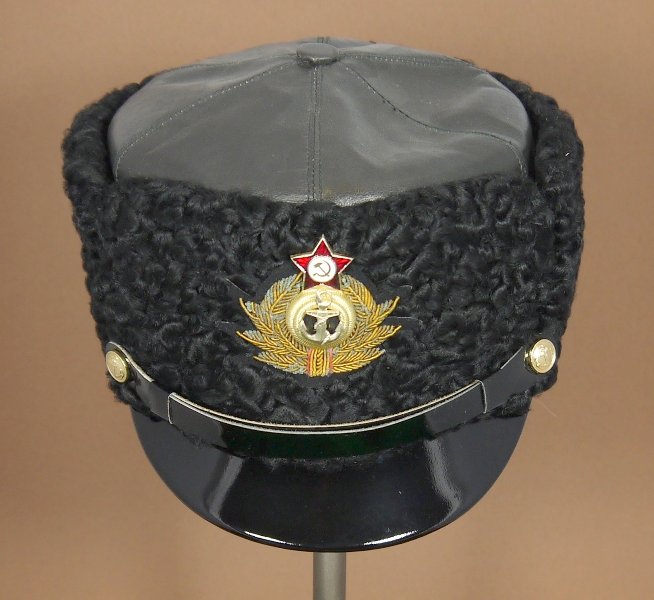
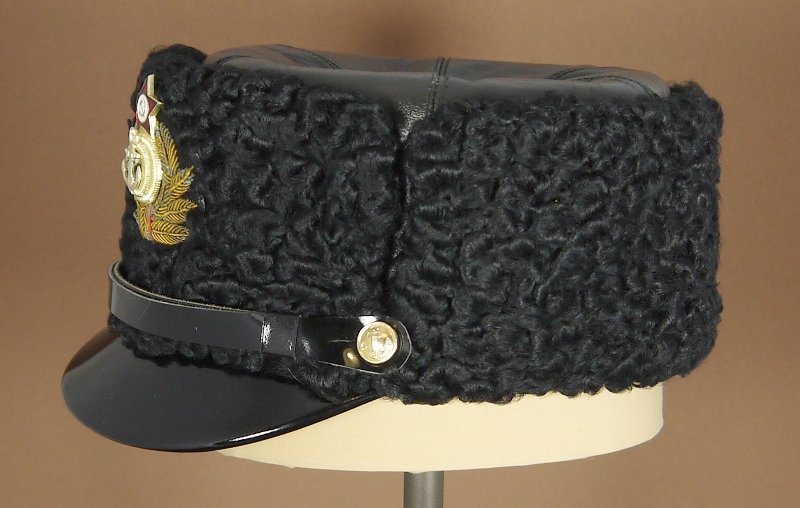 Captain 1st Rank
Captain 1st Rank
Winter Service
1973-1991
Also introduced in 1973, this hat was for wear only by Captains First Rank or Navy Colonels. As with the admiral's hat above, the body of the insulated cap is covered in black lambs-wool, while the visor and chinstrap are made of patent leather. However, the top of this hat is leather rather than lambs-wool, the visor has no embroidery, and the chinstrap buttons are normal naval anchor design, rather than admirals'.
A naval senior officer's embroidered cockade is worn on the front flap. Like its Admiral counterpart, this hat was intended to be worn with the winter overcoat or padded jacket with the service uniform. But unlike its admiral counterpart, this hat is no longer worn by the Russian Navy, having been replaced with a black wool visorless "shapka-ushanka".
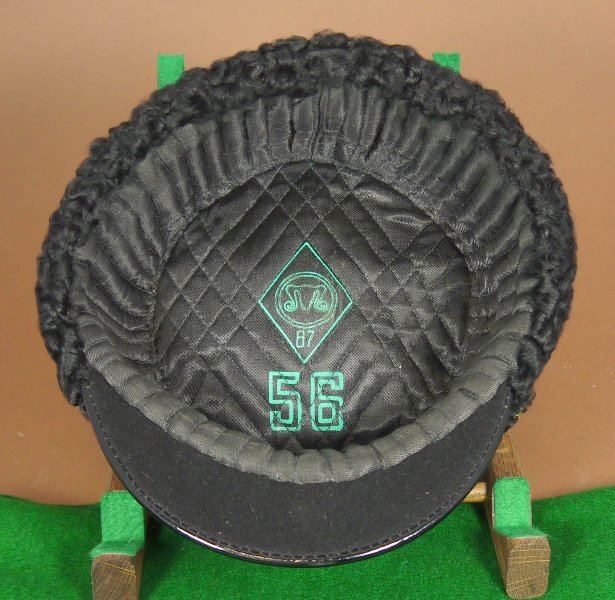
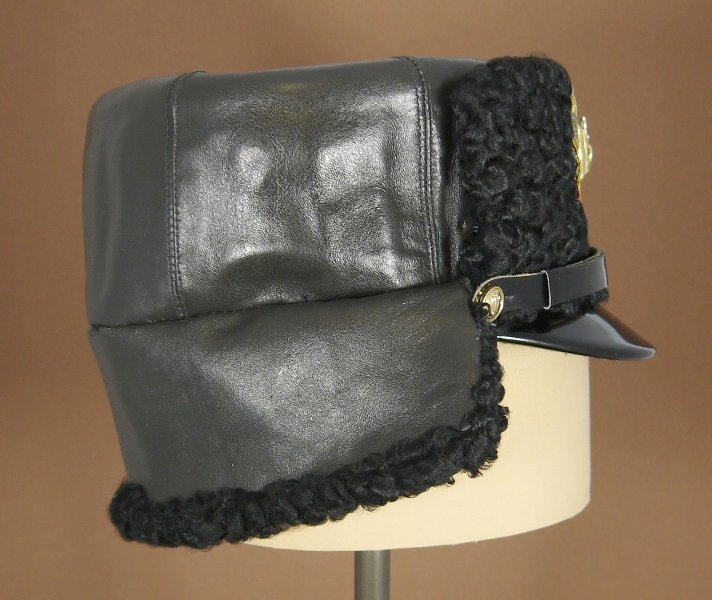
The last picture here shows how the flaps of both these wool caps would be turned down in inclement weather - just like the shapka-ushanka. However, I have never seen a picture showing one being worn that way indicating senior officers disapproved of such wear.
Scarce
Introduced around 1975 and still worn today, the Soviet Navy tropical field cap was worn by both officers and sailors in hot weather climes. It is made from lightweight blue cotton with white piping and uniquely has a detachable visor - held in place with small plastic buttons.
Interestingly enough, it closely resembles the Japanese field cap of World War 2.
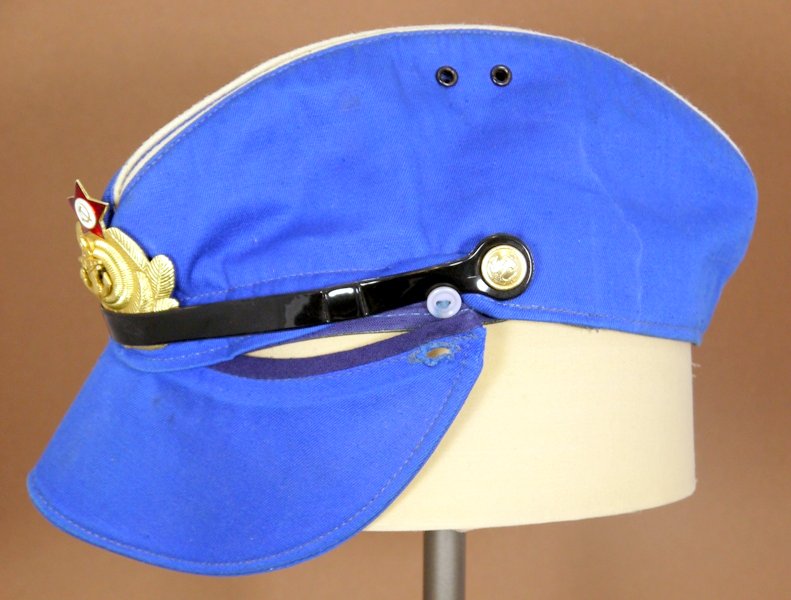 Both enlisted and officer personnel wore the same cap, differentiated usually only by the emblem (either the officer emblem as seen here - or with a red star (with or without the wreath) for sailors).
The black chinstrap was standard regardless of rank, although I have seen a few photographs showing officers wearing gold cords on this cap. While the visor was removable, photographs of personnel wearing the top only are relatively rare.
Available
Both enlisted and officer personnel wore the same cap, differentiated usually only by the emblem (either the officer emblem as seen here - or with a red star (with or without the wreath) for sailors).
The black chinstrap was standard regardless of rank, although I have seen a few photographs showing officers wearing gold cords on this cap. While the visor was removable, photographs of personnel wearing the top only are relatively rare.
Available
